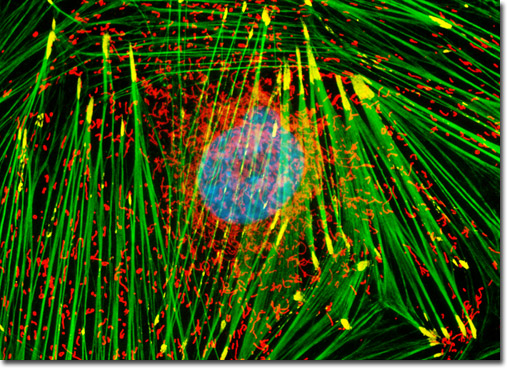Image Galleries
Featured Article
 Electron Multiplying Charge-Coupled Devices (EMCCDs)
Electron Multiplying Charge-Coupled Devices (EMCCDs)
By incorporating on-chip multiplication gain, the electron multiplying CCD achieves, in an all solid-state sensor, the single-photon detection sensitivity typical of intensified or electron-bombarded CCDs at much lower cost and without compromising the quantum efficiency and resolution characteristics of the conventional CCD structure.
Product Information
Digital Image Gallery
Fluorescence Microscopy Digital Image Gallery
Embryonic Rat Thoracic Aorta Cells (A7r5 Line)

In order to label the focal adhesions in the log phase adherent A7r5 culture featured above, the fixed and permeabilized cells were blocked and treated with mouse anti-vinculin primary antibodies followed by goat anti-mouse secondary antibodies (IgG) conjugated to Alexa Fluor 647 (pseucolored yellow). Filamentous actin was visualized with phalloidin conjugated to Alexa Fluor 488 (green), while the nuclei were stained with Hoechst 33258 (cyan). Prior to fixation, the cells were labeled with MitoTracker Red CMXRos for one hour to highlight the mitochondrial network (red). Images were recorded in grayscale with a Hamamatsu ORCA-AG camera system coupled to an Olympus BX-51 microscope equipped with bandpass emission fluorescence filter optical blocks provided by Semrock. During the processing stage, individual image channels were pseudocolored with RGB values corresponding to each of the fluorophore emission spectral profiles.






